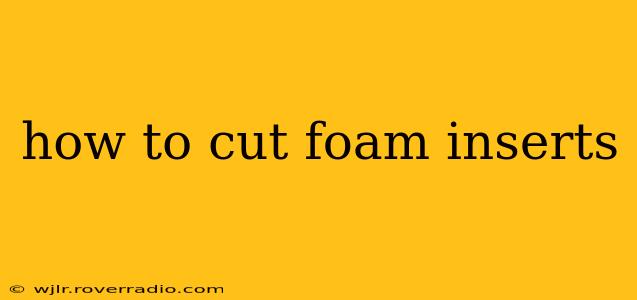Cutting foam inserts might seem simple, but achieving clean, precise cuts requires the right tools and techniques. Whether you're crafting custom inserts for your toolbox, creating protective packaging, or working on a larger project, this guide will walk you through the process, covering various foam types and offering tips for a professional finish.
What Type of Foam Are You Cutting?
Before diving into cutting techniques, it's crucial to identify the type of foam you're working with. Different foams have varying densities and require different approaches. Common types include:
- Polyurethane Foam: This is a versatile, widely available foam often used in packaging and cushioning. Its density can vary greatly, influencing the tools you should use.
- EVA Foam: Ethylene-vinyl acetate foam is softer and more flexible than polyurethane, making it ideal for crafts and protective layers. It’s easier to cut but can be prone to tearing if not handled carefully.
- PE Foam: Polyethylene foam is a lightweight, closed-cell foam often used for insulation and packaging. It's relatively easy to cut, but its density can affect the sharpness of the cut.
- High-Density Foam: This type of foam is much firmer and requires more robust tools for cutting.
What Tools Do You Need?
The best tools for cutting foam inserts depend on the foam type and the desired precision of the cut. Here are some options:
- Sharp Utility Knife: A sharp blade is essential for clean cuts in most foam types. Replace the blade frequently to maintain sharpness.
- Electric Knife: For larger projects or cutting high-density foam, an electric knife provides smoother, faster cuts.
- Hot Wire Foam Cutter: Ideal for intricate cuts and shaping, particularly in thicker foams. This method offers clean, precise results.
- Scissors: Suitable for softer foams, especially EVA foam, but might result in less precise cuts.
- Metal Ruler & Pencil: Essential for marking straight lines before cutting.
- Safety Glasses: Always protect your eyes when cutting foam.
How to Cut Foam Inserts: Step-by-Step Guide
Here's a general guide for cutting foam inserts using a utility knife, suitable for many common foam types:
-
Measure and Mark: Carefully measure the dimensions of the object you're creating an insert for. Transfer these measurements to the foam using a pencil and ruler. Mark clearly and precisely.
-
Secure the Foam: Use clamps or weights to keep the foam securely in place while cutting to prevent slippage and ensure straight lines.
-
Make Your Cuts: Use a sharp utility knife, applying even pressure and making slow, controlled passes. Avoid applying too much pressure at once, which can lead to jagged edges or tear the foam. For intricate shapes, use a combination of straight cuts and small cuts to create curves and angles.
### How do you cut foam cleanly?
Clean cuts are paramount for a professional finish and proper functionality of your foam inserts. Using a sharp blade, applying even pressure, and making multiple passes rather than trying to cut through in one go are crucial. A hot wire cutter is the best option for flawlessly clean cuts, particularly in thicker foams.
### What's the best way to cut foam board?
Foam board, often used in crafting and model making, is relatively easy to cut. A sharp utility knife, rotary cutter, or even a craft knife works well. Use a metal ruler as a guide for clean, straight lines. For curves, use small, precise cuts rather than attempting large sweeping motions.
### How do I cut thick foam?
Cutting thick foam requires more robust tools and techniques. An electric knife or a hot wire foam cutter is ideal for thick pieces. With a utility knife, make multiple passes, gradually cutting through the thickness without applying excessive pressure. A hot wire cutter provides smoother and more precise cuts in thick foam.
### What is the best tool for cutting foam?
The "best" tool depends on the type of foam and the desired precision. For most projects, a sharp utility knife is sufficient. For larger projects or high-density foams, an electric knife offers efficiency and smoother cuts. For intricate designs and clean cuts in thick foam, a hot wire foam cutter is unparalleled.
Finishing Touches and Safety
Once you’ve cut your foam insert, inspect it closely for any imperfections. You might need to use sandpaper to smooth any rough edges. Remember to always prioritize safety by wearing safety glasses and working in a well-ventilated area, especially when using electric tools or hot wire cutters.
By following these steps and choosing the right tools, you can create professional-looking and functional foam inserts for any project. Remember that practice makes perfect—the more you work with foam, the better you'll become at achieving precise and clean cuts.
